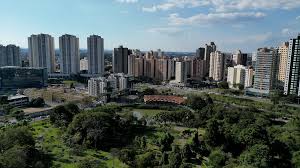Planned cities – a necessity for sustainable urbanisation
 VAIBHAV SHARMA
VAIBHAV SHARMA
India’s urban population is set to increase to 40% by 2036 and to 50% by 2047 as
per NITI Aayog. This rapid urbanization is being led not only by the big 8
metropolitan cities of the country, but also by the second and third tier towns such as
Amritsar, Srinagar and Kochi. Being a hub for economic activities, migrants both
skilled and unskilled come to cities in large number.
But to help the individual achieve their dreams and for the cities to emerge as
economic hubs, we need robust planning for public transport and urban housing to
name a few. Despite these pressing needs, NITI Aayog report highlights that as
many as 65% of the 7,933 urban settlements in India do not have any master plan.
 Such growth without planning will only lead to chaotic and messy urbanisation. The persistent air pollution in Delhi or the infamous traffic jams of Bangalore are a few such examples. Also with climate change, cities today need to adapt to the risk of diverse hazards ranging from floods to heatwave as seen recently in Ahmedabad.
Such growth without planning will only lead to chaotic and messy urbanisation. The persistent air pollution in Delhi or the infamous traffic jams of Bangalore are a few such examples. Also with climate change, cities today need to adapt to the risk of diverse hazards ranging from floods to heatwave as seen recently in Ahmedabad.
Further the Supreme court has remarked that the increase in illegal land encroachment by the jhuggi jhopdis is a failure of local bodies. Remedy to these issues lie in planned urbanisation.
First and foremost there is need to strengthen organisational capacity for planning. A
study by TCPO and NIUA highlights that over 12,000 posts for town planners are
required today against a sanctioned strength of 4,000 across the nation. To create a
large pool of human resource accessible courses should be brought in universities
similar to those being run in institutions like School of Planning and Architecture.
Further lateral entry at higher posts and common pool of personnel for smaller
municipalities can be explored.
Next, multiplicity of organisations from development authorities to special purpose
vehicles alongside urban local bodies has led to piecemeal planning efforts. A
common platform for planning can be found in Metropolitan Planning Committees
which currently lie defunct in many states. Upgrading them with representatives from
other parastatals along with elected representatives can help bring both quality and
public opinion into planning.
Leveraging technology should be one of the central pillars in urban planning.
Following in the footsteps of National Urban Digital Mission, Amplifi 2.0 portal has
been launched to bring all the data of urban local bodies in a single place for
researchers. So local bodies should be encouraged to digitise their functioning and
contribute to this repository. Also developing ‘digital twins’ for cities through PPP
mode is essential.
Moreover the definition of urban area needs to be revised. The current definition of
minimum 5,000 inhabitants, with a density of 400 people per sq. km and at-least
75% of working male population engaged in non-farm activities was set in 1961.
According to this definition, India had 31% urban population as per 2011 census but
satellite imagery and World Bank data shows that this figure has already crossed
50%. So there is need to revisit this definition so that the emerging peri-urban
spaces can be recognised and planned for in advance.
Another important aspect is of disaster resilient infrastructure. Climate sensitive
planning is a necessity to tackle extreme weather events. The proposed amendment
in disaster management act to establish Urban Disaster Management Authority for
larger cities is a step in the right direction. Emerging concepts of blue-green
infrastructure, Miyawaki forests and sponge cities also needs to be popularised.
A well planned city will ensure that Delhi’s modern metro connectivity, Indore’s
cleanliness or Pune’s economic rise can be present in each and every city of the
country. These steps need to be implemented by bringing coordination among all the
3 tiers of administration through the whole of government perspective. This will
provide a holistic master plan for developing our cities in the ‘Amrit Kaal’.

